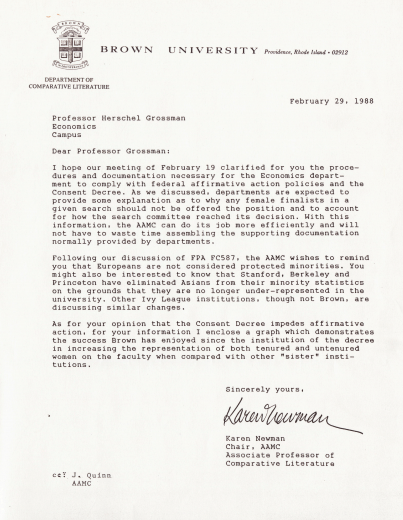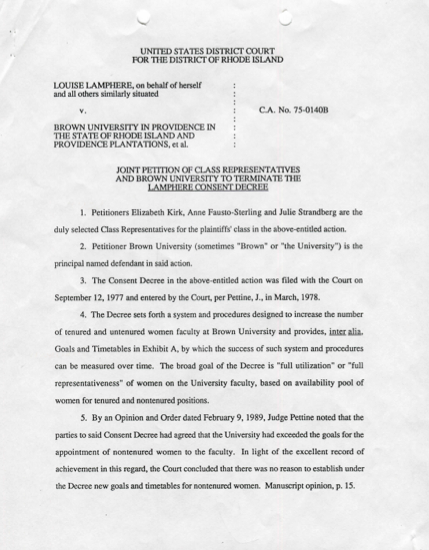Implementation: 1978-1992
Prior to the Consent Decree, Brown had no university-wide policies and procedures for hiring, tenure review, or promotion. The Consent Decree required that Brown establish policies and processes for hiring, promotion, and tenure. Today such processes are standard operating procedure at universities across the country, but at the time of the Lamphere case, they were hotly debated. The faculty at Brown was divided, with some supporting the reforms and others opposing them.
Monitoring Committee
The Affirmative Action Monitoring Committee (AAMC) was established in 1978. It was made up of Brown faculty members: two chosen by Lamphere's side, two by faculty vote, and a fifth selected by the committee.
This small committee had powerful leverage. Its mission was to review each department's criteria for hiring, contract renewal, promotion, and tenure and to make sure they were "detailed, clear, objective, and fair." The AAMC monitored the University's implementation of the goals and timetables for hiring women set forth in the Consent Decree and pressured departments with no women faculty to make special efforts to find qualified female candidates. Women aggrieved by departmental action could -- and did -- complain to the AAMC.
The AAMC also worked to achieve an important goal of the Consent Decree: to insure that women were represented in every department at Brown. The committee encouraged departments with no women faculty to seek out qualified female candidates and required that their demonstrate their efforts to do so. If a non-minority male was to be offered a job, the committee reviewed the department's search process and short list to make sure no woman candidate was as well-qualified as the non-minority male. The AAMC's annual report was submitted to the Court and made public.
Under the Consent Decree, Brown was "permanently enjoined from discriminating against women on the basis of sex with respect to all forms of employment." But the Decree only established goals and timetables through 1987, so as that year approached, debate broke out on campus about whether such goals -- and the AAMC itself -- were still needed.
First Attempt to Vacate
By 1987 the number of women faculty in the junior ranks had met the goals of the Consent Decree, but the university had not succeeded as robustly in promoting to the higher professorial ranks. Nor had the goal of "full representation" across departments yet been met. But President Swearer, and President-elect Vartan Gregorian, saw the Decree as "tying the university's hands" with regard to hiring opportunities.
During the fall of 1987, President Howard Swearer proposed to the Corporation's Advisory and Executive Committee that the Consent Decree be "vacated" -- i.e., eliminated. The Class Representatives and most Brown faculty opposed this idea. Unable to reach agreement on updated goals and timetables, in the summer of 1988 the University unilaterally petitioned the Court to vacate the decree. The Class Representatives and the AAMC objected. Chief Judge Pettine denied Brown's motion in February 1989 but urged all parties to continue negotiations over new goals, timetables, and procedures should the Consent Decree be vacated.
While this headline, "Women Faculty Appeal Latest Lamphere Decision," suggests that only women supported continuation of the Decree, as Professor of History William McLoughlin pointed out in the March 1989 issue of the Brown Alumni Monthly: "I attended the faculty meeting which voted on this issue and the heavily predominant male faculty voted overwhelmingly with women faculty against the administration."
SECOND ATTEMPT TO VACATE
In 1992, all parties presented a Joint Petition to the federal court that was granted by Judge Francis J. Boyle on May 22, 1992.
The Consent Decree, along with federal affirmative action efforts and expanding candidate pools, put Brown University ahead of most of its peers in the hiring, promotion, and tenure of women.
With regard to minority hiring, promotion, and retention, change had been much slower. Lamphere argued that the Consent Decree should also apply to minorities, but the University refused.
Improved search processes, however, also brought talented men to Brown that "a phone call to Harvard or Yale would not have reached," as Professor of Biology Ken Miller observed in the BAM. "More than 50 percent of the hires since the Consent Decree have been male. When you look wide and far to find qualified women, you find qualified men, too."
Data: American Association of University Professors
Karen Newman, Anne Fausto-Sterling, and Maurice Glicksman discuss the impact of the Consent Decree and the AAMC.






